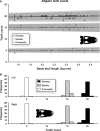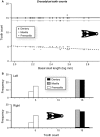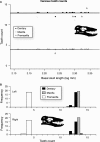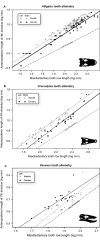Tooth counts through growth in diapsid reptiles: implications for interpreting individual and size-related variation in the fossil record
- PMID: 25689039
- PMCID: PMC4386932
- DOI: 10.1111/joa.12280
Tooth counts through growth in diapsid reptiles: implications for interpreting individual and size-related variation in the fossil record
Abstract
Tooth counts are commonly recorded in fossil diapsid reptiles and have been used for taxonomic and phylogenetic purposes under the assumption that differences in the number of teeth are largely explained by interspecific variation. Although phylogeny is almost certainly one of the greatest factors influencing tooth count, the relative role of intraspecific variation is difficult, and often impossible, to test in the fossil record given the sample sizes available to palaeontologists and, as such, is best investigated using extant models. Intraspecific variation (largely manifested as size-related or ontogenetic variation) in tooth counts has been examined in extant squamates (lizards and snakes) but is poorly understood in archosaurs (crocodylians and dinosaurs). Here, we document tooth count variation in two species of extant crocodylians (Alligator mississippiensis and Crocodylus porosus) as well as a large varanid lizard (Varanus komodoensis). We test the hypothesis that variation in tooth count is driven primarily by growth and thus predict significant correlations between tooth count and size, as well as differences in the frequency of deviation from the modal tooth count in the premaxilla, maxilla, and dentary. In addition to tooth counts, we also document tooth allometry in each species and compare these results with tooth count change through growth. Results reveal no correlation of tooth count with size in any element of any species examined here, with the exception of the premaxilla of C. porosus, which shows the loss of one tooth position. Based on the taxa examined here, we reject the hypothesis, as it is evident that variation in tooth count is not always significantly correlated with growth. However, growth trajectories of smaller reptilian taxa show increases in tooth counts and, although current samples are small, suggest potential correlates between tooth count trajectories and adult size. Nevertheless, interspecific variation in growth patterns underscores the importance of considering and understanding growth when constructing taxonomic and phylogenetic characters, in particular for fossil taxa where ontogenetic patterns are difficult to reconstruct.
Keywords: Alligator; Crocodylus; Diapsida; Dinosauria; Reptilia; Varanus; allometry; dentition.
© 2015 Anatomical Society.
Figures






Similar articles
-
Skull shape and feeding strategy in Sphenodon and other Rhynchocephalia (Diapsida: Lepidosauria).J Morphol. 2008 Aug;269(8):945-66. doi: 10.1002/jmor.10634. J Morphol. 2008. PMID: 18512698
-
From fins to limbs to fins: limb evolution in fossil marine reptiles.Am J Med Genet. 2002 Oct 15;112(3):236-49. doi: 10.1002/ajmg.10773. Am J Med Genet. 2002. PMID: 12357467 Review.
-
A new extinct species of alligator lizard (Squamata: Elgaria) and an expanded perspective on the osteology and phylogeny of Gerrhonotinae.BMC Ecol Evol. 2021 Sep 29;21(1):184. doi: 10.1186/s12862-021-01912-8. BMC Ecol Evol. 2021. PMID: 34587907 Free PMC article.
-
Illustrating ontogenetic change in the dentition of the Nile monitor lizard, Varanus niloticus: a case study in the application of geometric morphometric methods for the quantification of shape-size heterodonty.J Anat. 2015 May;226(5):403-19. doi: 10.1111/joa.12293. Epub 2015 May 4. J Anat. 2015. PMID: 25939576 Free PMC article.
-
A survey of the rock record of reptilian ontogeny.Semin Cell Dev Biol. 2010 Jun;21(4):432-40. doi: 10.1016/j.semcdb.2009.11.007. Epub 2009 Nov 11. Semin Cell Dev Biol. 2010. PMID: 19913104 Review.
Cited by
-
The Permian reptile Opisthodontosaurus carrolli: a model for acrodont tooth replacement and dental ontogeny.J Anat. 2018 Mar;232(3):371-382. doi: 10.1111/joa.12754. Epub 2017 Dec 6. J Anat. 2018. PMID: 29210080 Free PMC article.
-
A new short-faced archosauriform from the Upper Triassic Placerias/Downs' quarry complex, Arizona, USA, expands the morphological diversity of the Triassic archosauriform radiation.Naturwissenschaften. 2021 Jul 2;108(4):32. doi: 10.1007/s00114-021-01733-1. Naturwissenschaften. 2021. PMID: 34213630 Free PMC article.
-
Histological analysis of post-eruption tooth wear adaptations, and ontogenetic changes in tooth implantation in the acrodontan squamate Pogona vitticeps.PeerJ. 2018 Nov 8;6:e5923. doi: 10.7717/peerj.5923. eCollection 2018. PeerJ. 2018. PMID: 30425900 Free PMC article.
-
Quantitative heterodonty in Crocodylia: assessing size and shape across modern and extinct taxa.PeerJ. 2019 Feb 28;7:e6485. doi: 10.7717/peerj.6485. eCollection 2019. PeerJ. 2019. PMID: 30842900 Free PMC article.
-
The biochronology and palaeobiogeography of Baru (Crocodylia: Mekosuchinae) based on new specimens from the Northern Territory and Queensland, Australia.PeerJ. 2017 Jun 21;5:e3458. doi: 10.7717/peerj.3458. eCollection 2017. PeerJ. 2017. PMID: 28649471 Free PMC article.
References
-
- Arnold EN. Recently extinct reptile populations from Mauritius and Reunion, Indian Ocean. J Zool. 1980;191:33–47.
-
- Benton MJ. Tooth form, growth, and function in Triassic rhynchosaurs (Reptilia, Diapsida) Palaeontology. 1984;27:737–776.
-
- Brink KS, Reisz RR. Hidden dental diversity in the oldest terrestrial apex predator Dimetrodon. 2014. Nature Communications 5, Article number: 3269, doi: 10.1038/ncomms4269. - DOI - PubMed
-
- Carrano MT, Benson RB, Sampson SD. The phylogeny of Tetanurae (Dinosauria: Theropoda) J Syst Paleontol. 2012;10:211–300.
-
- Colbert EH. Variation in Coelophysis bauri. In: Carpenter K, Currie P, editors. Dinosaur Systematics: Approaches and Perspectives. Cambridge: Cambridge University Press; 1990. pp. 81–90. )
Publication types
MeSH terms
LinkOut - more resources
Full Text Sources
Other Literature Sources

